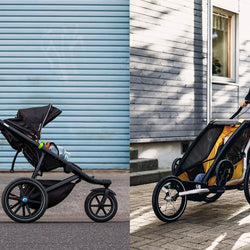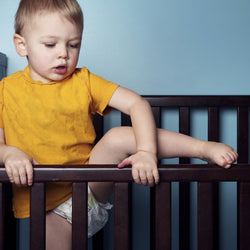Everything Parents Need to Know About Knob Puzzles {Toy Review}
Best features, impacts on development, and parental concerns about knob puzzles.

by Jess Wartinger
Dec 10, 2018
The benefits of puzzles on children’s development have been undisputed for years. Yet, you may be wondering how early to introduce puzzles and if knob puzzles are a good choice for your little one.
Everything Parents Need to Know about Knob Puzzles
We’re taking a look at everything you need to know about knob puzzles, from their best features to how they impact motor development, as well as some parental complaints about this common toy.
Features of Knob Puzzles
Knob puzzles are traditionally named such because each piece has a large handle (or knob) which a child grasps in order to lift the piece out of the puzzle as well as return it to its place. Commonly made of wood, these are sturdy toys that hold up to the wear and tear of everyday play. The knobs themselves come in various sizes, with the biggest ones most common in the easiest puzzles and smaller knobs (or pegs) on puzzles with more pieces.
The Best Things about Knob Puzzles
There’s lots to love about knob puzzles! Here are a few reasons why they’re always on gift lists for our littlest ones:
- Bigger Brains - Puzzles build kids brains in ways few other toys do. Spatial skills are developed as babies work to maneuver a piece into the perfect spot. Cause and effect concepts are strengthened as little ones see what happens when their puzzles pieces don’t match a designated opening. Furthermore, babies are introduced to the concept of matching as they look for two objects that are exactly the same. Knob puzzles are one of the easiest ways I’ve watched my kids develop better reasoning skills, even as babies and toddlers. It’s as if I am seeing connections being made right before my eyes.
- Stronger Hands - Knob puzzles are fantastic for building fine motor skills as well. The knobs themselves promote a grasp that uses the tips of baby's fingers (similar to a pincer grasp) and closely mirrors the grasp needed for writing. Therefore, babies and toddlers who use knob puzzles are building the hand muscles and coordination needed for writing. Puzzles are an important toy and the first step on baby’s journey towards writing.
- Less Noise - Knob puzzles fit squarely in the category of noiseless toys, which means less headache for parents and lots of benefits for babies. Puzzles build a child’s imagination, so that little ones get to be in charge of what happens with their puzzle pieces. Perhaps a farm animal is going to hop off the board and start making barnyard noises or a whale is going to swim off his puzzle and around your living room. Fun happens when children are in charge.
Parent Complaints about Knob Puzzles
Here are a couple of reasons knob puzzles aren’t always a household favorite:
- Storage Woes - Knob puzzle storage is precarious at best. With big knobs on each piece, it can get tricky and take up lots of space to store knob puzzles. Puzzle racks are available but aren’t space-saving so they might not be ideal for small spaces.
- Squished Fingers - Unpredictable babies and large wooden puzzle pieces can be a tricky combination. Watch carefully when baby plays with puzzles that he doesn’t squish any fingers.
Knob Puzzles: My Final Recommendation
Knob puzzles are one toy where benefits largely outweigh the minor downfalls. They’re fantastic for kids development and really are a great precursor to more involved puzzles for toddlers and preschoolers. This is definitely an item to invest in for your little one!
Check out our favorite knob puzzles available on Babywise.life:
Shop
Jess Wartinger
Jess Wartinger resides in rural New York with her husband and five children. Formerly an early elementary teacher, Jess currently spends her time loving her kids and holding down the fort at home.










